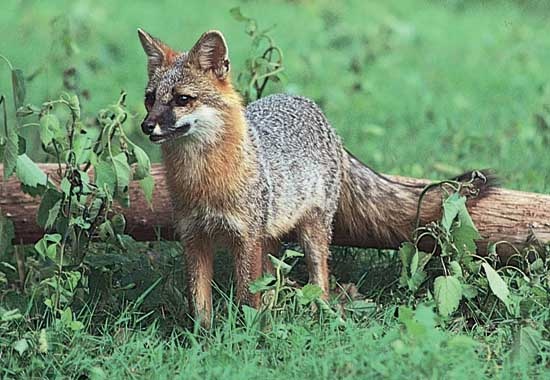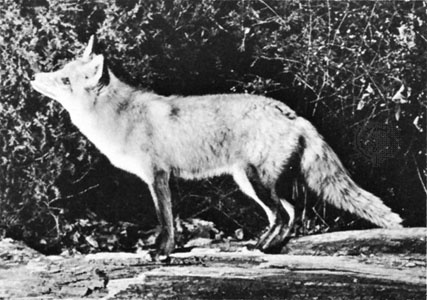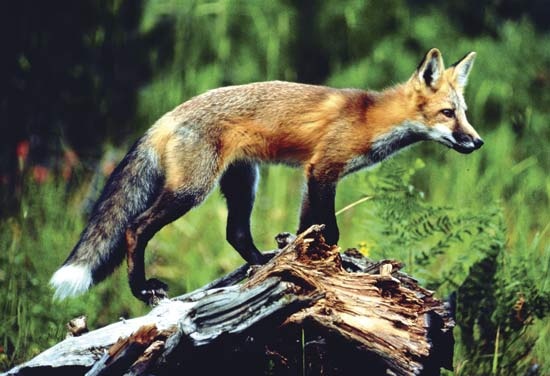fox
mammal
Introduction

 any of various members of the dog family (Canidae (canine)) resembling small to medium-sized bushy-tailed dogs with long fur, pointed ears, and narrow snouts. In a restricted sense, the name refers to the 10 or so species classified as “true” foxes (genus Vulpes), especially the red, or common, fox (V. vulpes), which lives in both the Old World and the New World. Several other foxes belong to genera other than Vulpes, including the North American gray fox, five species of South American fox, the Arctic fox (includes the blue fox), the bat-eared fox, and the crab-eating fox.
any of various members of the dog family (Canidae (canine)) resembling small to medium-sized bushy-tailed dogs with long fur, pointed ears, and narrow snouts. In a restricted sense, the name refers to the 10 or so species classified as “true” foxes (genus Vulpes), especially the red, or common, fox (V. vulpes), which lives in both the Old World and the New World. Several other foxes belong to genera other than Vulpes, including the North American gray fox, five species of South American fox, the Arctic fox (includes the blue fox), the bat-eared fox, and the crab-eating fox.The red fox
 Widely held as a symbol of animal cunning, the red fox is the subject of considerable folklore. (See Sidebar: .) The red fox has the largest natural distribution of any land mammal except human beings. In the Old World it ranges over virtually all of Europe, temperate Asia, and northern Africa; in the New World it inhabits most of North America. Introduced to Australia, it has established itself throughout much of the continent. The red fox has a coat of long guard hairs, soft, fine underfur that is typically a rich reddish brown, often a white-tipped tail, and black ears and legs. Colour, however, is variable; in North America black and silver (silver fox) coats are found, with a variable amount of white or white-banded hair occurring in a black coat. A form called the cross, or brant, fox is yellowish brown with a black cross extending between the shoulders and down the back; it is found in both North America and the Old World. The Samson fox is a mutant strain of red fox found in northwestern Europe. It lacks the long guard hairs, and the underfur is tightly curled.
Widely held as a symbol of animal cunning, the red fox is the subject of considerable folklore. (See Sidebar: .) The red fox has the largest natural distribution of any land mammal except human beings. In the Old World it ranges over virtually all of Europe, temperate Asia, and northern Africa; in the New World it inhabits most of North America. Introduced to Australia, it has established itself throughout much of the continent. The red fox has a coat of long guard hairs, soft, fine underfur that is typically a rich reddish brown, often a white-tipped tail, and black ears and legs. Colour, however, is variable; in North America black and silver (silver fox) coats are found, with a variable amount of white or white-banded hair occurring in a black coat. A form called the cross, or brant, fox is yellowish brown with a black cross extending between the shoulders and down the back; it is found in both North America and the Old World. The Samson fox is a mutant strain of red fox found in northwestern Europe. It lacks the long guard hairs, and the underfur is tightly curled.Red foxes are generally about 90–105 cm (36–42 inches) long (about 35–40 cm of this being tail), stand about 40 cm at the shoulder, and weigh about 5–7 kg (10–15 pounds). Their preferred habitats are mixed landscapes, but they live in environments ranging from Arctic tundra to arid desert. Red foxes adapt very well to human presence, thriving in areas with farmland and woods, and populations can be found in many large cities and suburbs. Mice, voles, and rabbits, as well as eggs, fruit, and birds, make up most of the diet, but foxes readily eat other available food such as carrion, grain (especially sunflower seeds), garbage, pet food left unattended overnight, and domestic poultry. On the prairies of North America, it is estimated that red foxes kill close to a million wild ducks each year. Their impact on domestic birds and some wild game birds has led to their numbers often being regulated near game farms and bird-production areas.
The red fox is hunted for sport (see foxhunting) and for its pelt, which is a mainstay of the fur trade. Fox pelts, especially those of silver foxes, are commonly produced on fox farms, where the animals are raised until they are fully grown at approximately 10 months of age. In much of their range, red foxes are the primary carrier of rabies. Several countries, especially the United Kingdom and France, have extensive culling and vaccination programs aimed at reducing the incidence of rabies in red foxes.
Red foxes mate in winter. After a gestation period of seven or eight weeks, the female (vixen) gives birth to 1–10 or more (5 is average) young, called cubs or pups. Birth takes place in a den, which is commonly a burrow abandoned by another animal. It is often enlarged by the parent foxes. The cubs remain in the den for about five weeks and are cared for by both parents throughout the summer. The young disperse in the fall once they are fully grown and independent.
Classification
Listed below are the true foxes of the genus Vulpes.
V. bengalensis (Bengal, or Indian, fox)
Small (1.5–3 kg) and gray; found in sparsely wooded regions of the Indian subcontinent.V. cana (Blanford's, or hoary, fox)
Small (1–2 kg) and catlike, with soft fur and a long bushy tail; found in the mountain steppes and deserts of Iran, Pakistan, Afghanistan, and Israel; coat gray above, white below.V. chama (Cape fox (bat-eared fox), South African silver fox, or chama)
Long-eared fox inhabiting dry areas of Southern Africa, particularly in the Kalahari desert region; weight of 4 kg, body length usually less than 60 cm; coat gray.V. corsac (corsac, or steppe, fox)
Small and social steppe-dwelling fox that inhabits steppes and semideserts of eastern Eurasia; coat yellowish gray or brown to reddish gray; body similar in form to the red fox, but with larger legs and ears.V. ferrilata (Tibetan fox)
Short-eared, short-tailed fox of the barren slopes and streambeds of Nepal; length to 70 cm, weight up to 4 kg or more; colour is variable.V. pallida (pale fox)
1.5–3.5-kg fox inhabiting the Sahel savannas and southern desert margin of northern Africa; coat yellow to brown; similar in form to the red fox, but with longer legs and ears.V. rueppelli (sand fox)
Big-eared fox of the deserts of northern Africa southward to the Sudan; also found in Saudi Arabia and southwestern Asia; weight usually 2 or 3 kg, length to 80 cm, including tail; coat sandy or silvery gray with black patches on the face.V. velox (swift fox)
Sometimes considered as two species, V. velox (swift fox) and V. macrotis (kit fox); large-eared pale foxes of the western North American plains (swift fox) and deserts (kit fox); shy and uncommon; adult length about 40–50 cm without the 20–30-cm tail, weight about 1.5–3 kg; burrow-dweller that feeds on small animals (rodents, rabbits, insects); coat gray to yellowish brown with black-tipped tail.V. vulpes (red fox)
Large (5–7-kg) fox of North America, Eurasia, and northern Africa, and introduced to Australia; length 90–105 cm, including the 35–40-cm tail; coat typically reddish brown but variable.V. zerda ( fennec)
Smallest fox (about 1 kg), often classified in its own separate genus; adaptations for North African desert life include hairy soles to facilitate traction and protect feet from hot sand as well as huge ears to detect burrowing insects and small mammals; coat light tan.
- Budaun
- Buddha
- Buddhacarita
- Buddhaghosa
- Buddhapālita
- Buddhism
- Buddhist council
- Buddhist Hybrid Sanskrit language
- Buddhist meditation
- budding
- budding bacterium
- Budd Schulberg
- Buddy Bolden
- Buddy Guy
- Buddy Holly
- Buddy Holly's record collection
- Buddy Rich
- Budenny, Semyon Mikhaylovich
- Buderim
- Bud Fisher
- Bud Freeman
- Budge Budge
- Budge, Don
- Budgell, Eustace
- budgerigar